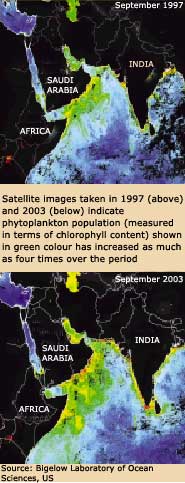In one of the most comprehensive looks yet at the oceans, researchers say that humans have "strongly' fouled 41 per cent of the high seas with everything from storm water runoff to shipping waste and that only small polar regions are still untouched. "Almost half of the oceans are in a fairly degraded state, based on what we found,' said Benjamin Halpern, the report's lead author and a marine biologist at the California-based National Centre for Ecological Analysis and Synthesis. "There isn't a spot on the planet that hasn't been touched by humans.' The report, being published Friday in the journal Science and presented at a scientific conference this week in Boston, is designed to summarise how humans are affecting the 70 per cent of the planet covered by the seas. "You just can't manage fisheries alone or try to just manage nutrient runoff or invasive species by themselves. You have to think of them in a more comprehensive context,' said Donald F. Boesch, a professor of marine science and president of the University of Maryland Centre for Environmental Science. The international team of 19 researchers looked at effects from 17 human activities, including commercial fishing, runoff from development, invasive species, industrial pollution, oil rigs and climate change. Their sources included satellite imagery, UN reports on fisheries harvests, estimates of commercial shipping wastes and runoff from pesticide use. "The oceans are in trouble, in a lot of areas and in a lot of ways,' said Andrew Rosenberg, a professor of natural resources at the University of New Hampshire who reviewed the study. Only 3.7 per cent of the oceans have seen little or no effect from human activity and they lie near the North and South poles, the researchers say. The most polluted areas are along the Atlantic's eastern seaboard, as well as in the North Sea, Caribbean, Red Sea, Bering Sea, the Persian Gulf and the China seas. "Hopefully, this is a wakeup call showing what our impacts are on the oceans and what can be done to minimise them,' Halpern said. There have been previous alarms. A $5-million report by the Pew Ocean Commission in 2003 called for restoring coastline ecosystems, improving the way fisheries are managed and cracking down on sources of pollution. But experts say Halpern's report goes further. "This changes how we view the oceans by showing how widely scattered our impacts are,' said Boris Worm, a marine biologist at Dalhousie University in Halifax, Canada. Worm was co-author of a report in 2003 that predicted a collapse of the world's fisheries by mid-century if human effects continue at their current pace. The most severely troubled waters lie within dozens of miles of most coastlines. It is there that effects from land and ocean-based activities show up, such as the depletion of fish stocks from commercial fishing and sediment runoff from coastal development. Industrial fishing fleets equipped with sonar and global positioning systems have fished the seas to the point that about 90 per cent of the worldwide stocks of tuna, cod and other large fish have disappeared, experts say. To help address the problem, people should be careful to eat fish harvested with sustainable, environmentally conscious methods and try to reduce greenhouse gas emissions by driving smaller cars, Halpern said. They also should avoid fertilisers and pesticides, he said. "There are things people can do.'





